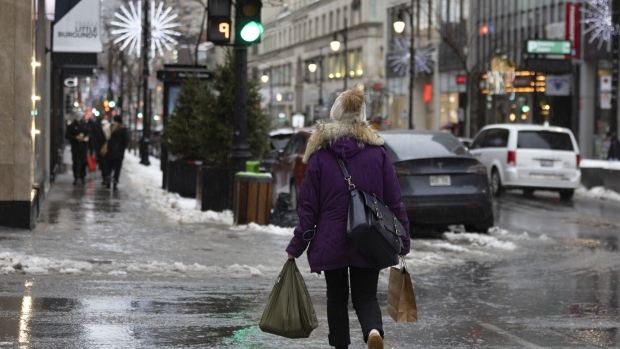Feb 20, 2024
Canada Inflation Slows More Than Expected to 2.9% in January
, Bloomberg News

(Bloomberg) -- Canadian consumer prices eased at the start of this year, with progress on underlying pressures likely to give the Bank of Canada more room to start considering rate cuts in the coming months.
The consumer price index rose 2.9% in January from a year ago, following a 3.4% increase in December, Statistics Canada reported in Ottawa. That was slower than the median estimate of 3.3% in a Bloomberg survey of economists, and marks the first time since June that the headline rate fell to within the central bank’s control range.
Bonds jumped and the Canadian dollar weakened. The yield on benchmark two-year debt plunged to just below 4.17%, down about 13 basis points on the day.
On a monthly basis, the index was unchanged, versus expectations for an increase of 0.4% and following a 0.3% decline in December.
The Bank of Canada’s two preferred core inflation measures both decelerated, averaging 3.35% from a downwardly revised 3.6% a month earlier, also slower than the 3.6% pace expected by economists.
A three-month moving average of the rates fell to an annualized pace of 3.22% from 3.63% in December, according to Bloomberg calculations.
“Overall, it appears that the sluggishness in consumer demand is finally impacting pricing in areas of more discretionary spending,” Andrew Grantham, an economist at Canadian Imperial Bank of Commerce, said in a report to investors. “That is a positive sign for the Bank of Canada, and will have financial markets pulling forward expectations for a first interest rate cut today, which we see being delivered in June.”
January’s data show disinflation progress resuming after price pressures reversed course at the end of last year. With the Bank of Canada now weighing how long its policy rate needs to remain restrictive, the report will help alleviate some concerns about the stickiness of underlying inflation.
During their January deliberations, Governor Tiff Macklem and his officials viewed the current stance of monetary policy as sufficiently restrictive to achieve the target and said more time is needed to restore price stability. They expect inflation to remain around 3% in the first half of this year before gradually easing and reaching the 2% target next year.
Travel, Food Prices
This is the only inflation report before the next rate decision on March 6. Economists widely expect officials to hold policy rates at 5% for a fifth straight meeting, and predict the easing cycle to start around mid-2024.
Traders in overnight swaps brought forward their bets for when the central bank will start cutting interest rates, putting the odds at nearly a coin flip for the April meeting, from about 25% previously.
The data also underscore a divergence between Canada and US inflation last month. US consumer prices rose by more than forecast across the board — on a monthly and annual basis — as did the core measures. That reduced market expectations for Federal Reserve officials to start lowering interest rates.
“I think that this really does open the door for the Bank of Canada to move ahead of the Federal Reserve,” Lesley Marks, chief investment officer of equities for Mackenzie Investments, said on BNN Bloomberg Television.
Canada is more rate-sensitive compared with the US due to higher debt loads and shorter-duration mortgages.
In January, the largest contributor to headline deceleration in Canada was lower year-over-year prices for gasoline, which were down 4%. Excluding gasoline, the index slowed to 3.2% from a year ago and down from 3.5% in December.
Slowing grocery inflation and lower prices for airfares and travel tours also contributed to the deceleration.
Four components in the CPI basket — food, shelter, health and personal care and alcoholic beverages and tobacco and cannabis products — rose at a rate above 3%. Collectively, they made up about 55% of the basket weights.
Inflation excluding food rose 2.7%, while excluding food and energy, it increased 3.1%.
Mortgage interest costs and rent remained the biggest contributors to year-over-year price gains. Mortgage interest costs jumped 27.4% from a year ago and rent rose 7.9%.
Excluding shelter costs, the consumer price index rose 1.5% from a year ago.
Policymakers have said they are concerned shelter inflation would keep overall price gains elevated. If the housing market rebounds more than expected in the coming months, shelter prices could keep overall inflation above the target even while price pressures in other parts of the economy abate.
Regionally, prices increased at a slower pace from a year ago compared with December in nine of 10 Canadian provinces.
Alberta was the only province with faster price growth, partly due to higher electricity prices compared with December as a result of a base-year effect. The large monthly decline in January last year when Albertan households received rebates on their electricity bills is no longer affecting the year-over-year movement.
--With assistance from Erik Hertzberg.
(Updates with more details and market reaction.)
©2024 Bloomberg L.P.






